- Books Name
- Social Science Book
- Publication
- Cognizance Publication
- Course
- CBSE Class 7
- Subject
- Social Science
Chapter 3
Our Changing Earth
The earth’s crust consists of several large and some small, rigid, irregularly shaped plates which carry continents and the ocean floor.These plates are known as Lithospheric plates. These plates move around very slowly, just a few millimetres each year. This is because of the movement of the molten magma inside the earth.The movement of these plates causes changes on the surface of the earth.The earth movements are divided on the basis of the forces which cause them.
Endogenic forces- The forces which act in the interior of the Earth.
Exogenic forces- The forces that work on the surface of the Earth.
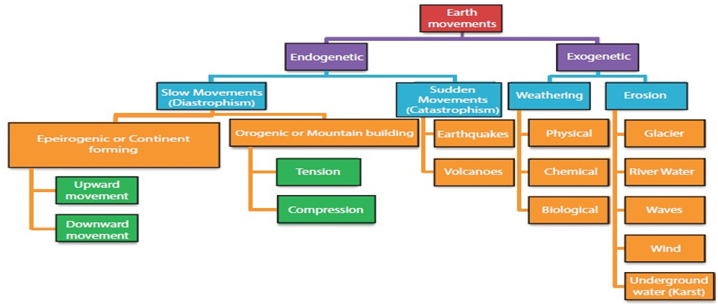
Endogenic forces
Literal meaning of dope means ‘inside’ genic means ‘origin’.Endogenic forces sometimes produce sudden movements and at the other time produce slow movements.Sudden movements like earthquakes and volcanoes caused mass destruction over the surface of the earth.
Volcano
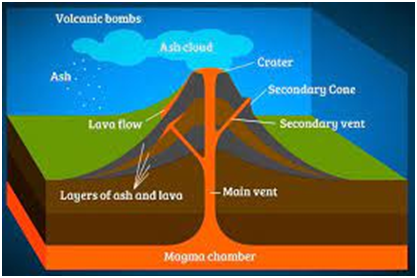
Volcano is a vent in the Earth's crust, through which molten material erupts suddenly. It is well known that the earth’s interior is very hot and as the depth increases from the surface, the temperature too increases and heat rises, ultimately, the heated rock (magma) begins rising slowly towards the surface. They escaping gases provide the driving force for volcanic eruptions, and these volcanic gases are known as steam. Then, this gas-filled magma rises and collect in large pools called magma chambers. As the magma becomes lighter in weight, it rises through channels. When it reaches the surface, it discharges out of vents or openings at the top of the channels. Thus, when the magma(molten rock) discharges out of the vents is known as lava.
A calderais a volcanic feature formed by the collapse of a volcano into itself, making it a large, special form of a volcanic crater.
Earthquakes and Epicentre
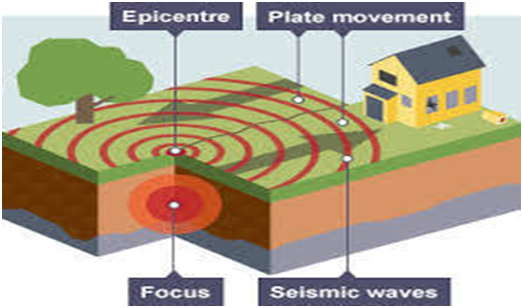
When the Lithospheric plates move, the surface of the earth vibrates. The vibrations can travel all round the earth. These vibrations are called earthquakes.The place in the crust where the movement starts is called the focus. The place on the surface above the focus is called the epicentre. Greatest damage is, usually closest to the epicenter and the strength of the earthquakedecreases away from the centre.
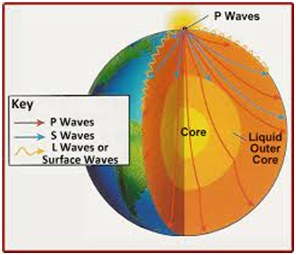
There are 3 types of earthquake waves.
P waves or longitudinal waves.
S waves or transverse waves.
L waves or surface waves.
Although earthquake cannot be predicted. However, the impact can certainly be minimised if we have prepared beforehand.Some common earthquake prediction methods adopted locally by people include studying animal behaviour,fish in the pond get agitated,snakes come out of the surface.
Seismograph
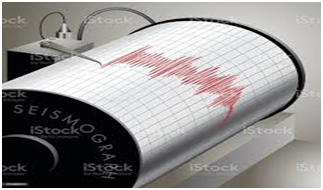
An earthquake is measured with a machine called a seismograph. The magnitude of the earthquake is measured on the Richter scale. An earthquake of 2.0, or less can be felt only a little.An earthquake over 5.0 can cause damage from things falling.A 6.0 or higher magnitude is considered very strong and 7.0 is classified as a major earthquake.
Earthquake preparedness
Where do we take shelter during an earthquake.
Safe spot- Under a kitchen counter, table or desk against an inside corner or wall.
Stay Away from.- Fire places, areas around chimneys, windows that shatter including mirrors and picture frames.
Be prepared- Spread awareness amongst your friends and family members and face any disaster confidently.
Exogenic forces
Literal meaning of exo means outside genic means origin.

 Cognizance Publication
Cognizance Publication
